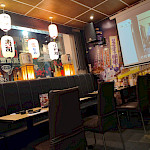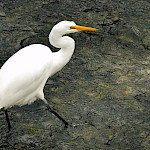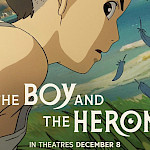3 Feb 2024
JETAA News
9th January 2017
Chapter Roundup: Scotland
JETAA Scotland had another busy year in 2016. Highlights include:
- JLPT Bootcamp
- Edinburgh Fringe
- Fuji Festival
JLPT Bootcamp
Nihongo Scotland, a Japanese language group organised by JETAA Scotland, ran its first Japan Language Proficiency Test (JLPT) Bootcamp in collaboration with the University of Edinburgh on 18–20 November, 2016. The bootcamp was organised by JETAA members Jess Brown and Emma Boardman. Attendees came from JETAA, Edinburgh University or were self-taught private learners.
Of the 23 attendees, there was one organiser, two mock test invigilators, 16 students, one student assistant and three teachers. Of the 16 students, six were preparing to sit the JLPT in Edinburgh, in December 2016. The other 10 attendees were a mix of those who plan to take the JLPT in Edinburgh, in July 2017, and those who attended purely for the immersive Japanese language experience.
In operation since summer 2014, Nihongo Scotland began as a small weekly study group for ex-JETs and has grown to welcome students of Japanese from the wider community. Aside from hosting the JLPT Bootcamp, Nihongo Scotland has performed a play in Japanese at an event hosted by the Consulate-General of Japan in Edinburgh and a Japanese language immersion day trip to North Berwick, East Lothian.
Feedback from bootcamp
“I enjoyed everyone’s company at bootcamp and really learnt a lot. All in all it was a fantastic weekend and I feel much better prepared for my N4 exam next month—thank you.”
“It was a marvellous weekend … Thank you again for making the bootcamp retreat happen, I think you both have a special talent to have made it such a successful weekend; I would never have guessed it was your first one.”
“Thank you for organising the bootcamp, I had so much fun! It was amazing. :)”
Edinburgh Festival Fringe events
In August, 2016, JETAA Scotland managed to fit in three shows at the Edinburgh Festival Fringe for our members, with the opportunity to meet the performers, as well as a social event to welcome visiting ex-JETs.
7 August: Japan’s Elegant Breeze
This beautifully relaxing show was followed by drinks with the performers.
14 August: Rakugo
We managed to fill up a good portion of the audience for the Katsura Sunshine Rakugo show. The brilliant performance was followed by drinks with the star!
21 August: UTO taiko
The show was extremely energetic and we highly recommend it. The performers are from Kumamoto, so when we had a quick informal chat with the performers after the show, they told us how Kumamoto has been getting on since the series of earthquakes there in April 2016.
Social event with visiting JETAA members
British ex-JET Sarah Parsons visited from JETAA Midlands at the same time as Canadian ex-JET Mike Miller visited from Japan so we took them both out to show JETAA Scotland hospitality. The evening began at Hakataya on Rose Street and ended with karaoke in Supercube.
Fuji Festival
Fuji Festival is a collaboration between schools, government, charities and local businesses to provide a Japanese experience for pupils in Scotland.
In April 2016, around 100 pupils at Law Primary School enjoyed a packed afternoon of Japanese activities. Their Japanese adventure was filmed and broadcast to every school in Scotland via the Glow TV network, along with interviews between the children and the Consul General of Japan.
Timed to coincide with teaching about Japan in the Scottish curriculum, the event featured a range of learning opportunities through stalls in a large hall that showcased aspects of Japanese culture, from sushi, clothes and calligraphy to taiko drumming, virtual reality tours of Tokyo and judo.
The event was staffed by teachers, volunteers from JETAA Scotland, and representatives from Education Scotland, an executive agency of the Scottish Government; the Japan Karate Foundation; Ichigumi Taiko Group; Minato Sushi, a local sushi delivery service; the Japan Society of the University of Edinburgh; and the Consulate-General of Japan in Edinburgh.
As is the Japanese way, the group began with a collective greeting, led by the Consul General of Japan. This included learning how to bow, followed by a brief talk about some illustrative differences between the UK and Japan.
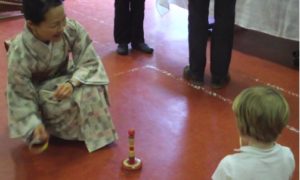 There were kimonos and geta (Japanese wooden shoes) for children to dress up in as well as fans to use. There were also toys such as spinning tops and bricks to play traditional Japanese games.
There were kimonos and geta (Japanese wooden shoes) for children to dress up in as well as fans to use. There were also toys such as spinning tops and bricks to play traditional Japanese games.
Learners used their hands to make a traditional Japanese rice ball. These rice balls are normally made from solely plain rice or filled with a range of simple ingredients. We used plain rice, prepared beforehand and set out in the correct amounts on individual paper plates. All the right scaffolding was in place, therefore, to give learners the satisfaction of making and eating a simple, tasty snack.
The Japan Karate Association gave a demonstration and showed simple, moderate exercises that learners could try without the need for special clothing.
Taiko drummers in full costume drummed children into and out of the hall. A stall throughout the event was the setting for children to see the drums and ask questions.
Volunteers from the Japan Society of the University of Edinburgh gave children a demonstration of Japanese calligraphy and supported them to try the art using black felt tips and paper. Children were shown their own name in katakana (the alphabet for foreign words) and given help to write it on a paper bag, provided for them to take home.
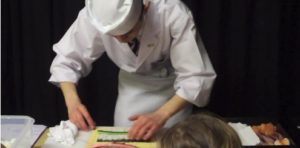 Learners watched a sushi expert from the Japanese consulate create sushi, which they could eat. This activity has been carried out in several schools in Scotland and was a real hit on the day.
Learners watched a sushi expert from the Japanese consulate create sushi, which they could eat. This activity has been carried out in several schools in Scotland and was a real hit on the day.
Volunteers from JETAA gave children a demonstration of simple origami forms and then helped them to create some.
At the end of the event, the children were brought together for a traditional Japanese closing ceremony.
Video footage of the children’s Japanese adventure was broadcast on Glow TV, with a presenter from Education Scotland. On the programme, learners were asked about their experiences by other schools. The Consul General of Japan was asked questions about Japan (such as “How high is Mount Fuji?”). The children sang karaoke together in Japanese. Finally, we said good-bye in Japanese and bowed, as we had learnt to do at the beginning. Learners created pictures and wrote about their experiences.
The coverage is available via Glow TV as a resource for Scottish schools. A video of the event, produced by Education Scotland, is available on Vimeo.
There were a number of smaller, follow-on events that consolidated the Japanese experiences in the minds of learners and their families. Nihongo Scotland visited North Berwick Primary School and left some mystery messages for Law Primary School pupils (the meaning of which was later revealed by teaching staff). Parents were treated to performances of the song, Head, Shoulders, Knees and Toes, in Japanese, at pick up time.
A Japanese-themed section of the end of year celebration of the children’s learning featured revision of numbers in Japanese, in which parents were invited to take part. Other presentations by the children showed what they had learnt during the event.
There are plans to expand the event in five main ways next year.
- A tie up with a Japanese school is being sought; Education Scotland are advising on how that might be supported with digital technology.
- Teachers and Education Scotland are proposing to run Friday afternoon sessions for six weeks as part of the Parent Learning programme, where parents join their children for learning experiences. This would involve all age groups.
- A blog, recording the large number of events, is being proposed.
- Teachers are proposing that children in P7 experience origami as part of a specific drive to focus on fine motor skills.
- The main event with stalls will be held on a Saturday and open to all year groups.
These various changes will be important for increasing the range of Scottish schools who share the learning experience through the Glow TV live link-up or the watch-again service. The broader range of ages will make any digital events and materials relevant to a wider range of students. In addition, the significant parental involvement in 2016 reflects the popularity of the theme and events held to date.







